NVIDIA GeForce GTX 680 Review: Retaking The Performance Crown
by Ryan Smith on March 22, 2012 9:00 AM ESTCompute: What You Leave Behind?
As always our final set of benchmarks is a look at compute performance. As we mentioned in our discussion on the Kepler architecture, GK104’s improvements seem to be compute neutral at best, and harmful to compute performance at worst. NVIDIA has made it clear that they are focusing first and foremost on gaming performance with GTX 680, and in the process are deemphasizing compute performance. Why? Let’s take a look.
Our first compute benchmark comes from Civilization V, which uses DirectCompute to decompress textures on the fly. Civ V includes a sub-benchmark that exclusively tests the speed of their texture decompression algorithm by repeatedly decompressing the textures required for one of the game’s leader scenes. Note that this is a DX11 DirectCompute benchmark.
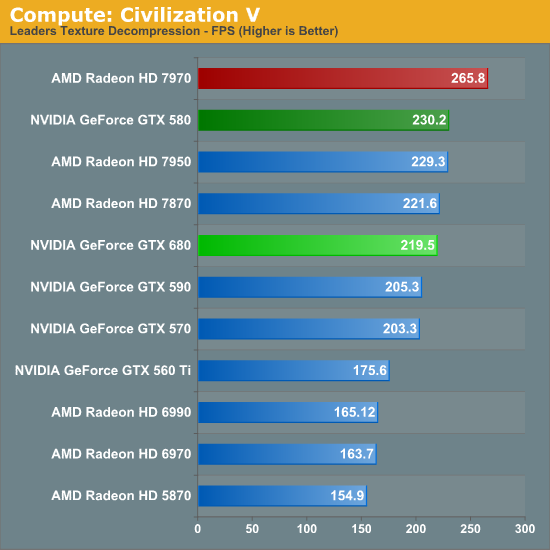
Remember when NVIDIA used to sweep AMD in Civ V Compute? Times have certainly changed. AMD’s shift to GCN has rocketed them to the top of our Civ V Compute benchmark, meanwhile the reality is that in what’s probably the most realistic DirectCompute benchmark we have has the GTX 680 losing to the GTX 580, never mind the 7970. It’s not by much, mind you, but in this case the GTX 680 for all of its functional units and its core clock advantage doesn’t have the compute performance to stand toe-to-toe with the GTX 580.
At first glance our initial assumptions would appear to be right: Kepler’s scheduler changes have weakened its compute performance relative to Fermi.
Our next benchmark is SmallLuxGPU, the GPU ray tracing branch of the open source LuxRender renderer. We’re now using a development build from the version 2.0 branch, and we’ve moved on to a more complex scene that hopefully will provide a greater challenge to our GPUs.
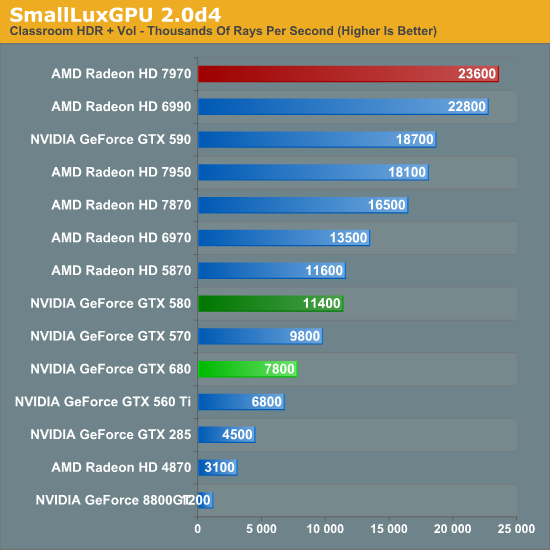
CivV was bad; SmallLuxGPU is worse. At this point the GTX 680 can’t even compete with the GTX 570, let alone anything Radeon. In fact the GTX 680 has more in common with the GTX 560 Ti than it does anything else.
On that note, since we weren’t going to significantly change our benchmark suite for the GTX 680 launch, NVIDIA had a solid hunch that we were going to use SmallLuxGPU in our tests, and spoke specifically of it. Apparently NVIDIA has put absolutely no time into optimizing their now all-important Kepler compiler for SmallLuxGPU, choosing to focus on games instead. While that doesn’t make it clear how much of GTX 680’s performance is due to the compiler versus a general loss in compute performance, it does offer at least a slim hope that NVIDIA can improve their compute performance.
For our next benchmark we’re looking at AESEncryptDecrypt, an OpenCL AES encryption routine that AES encrypts/decrypts an 8K x 8K pixel square image file. The results of this benchmark are the average time to encrypt the image over a number of iterations of the AES cypher.
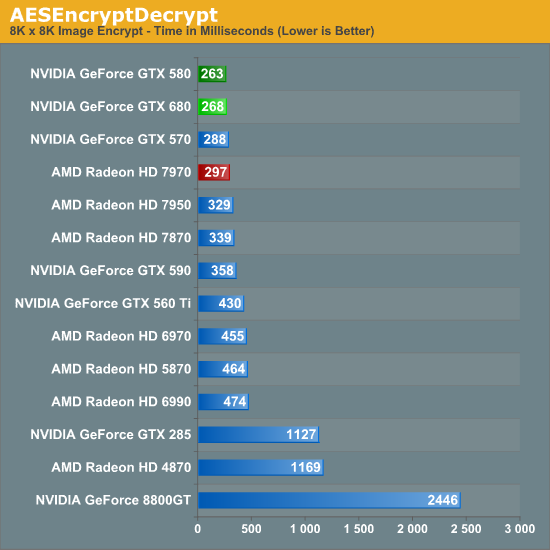
Starting with our AES encryption benchmark NVIDIA begins a recovery. GTX 680 is still technically slower than GTX 580, but only marginally so. If nothing else it maintains NVIDIA’s general lead in this benchmark, and is the first sign that GTX 680’s compute performance isn’t all bad.
For our fourth compute benchmark we wanted to reach out and grab something for CUDA, given the popularity of NVIDIA’s proprietary API. Unfortunately we were largely met with failure, for similar reasons as we were when the Radeon HD 7970 launched. Just as many OpenCL programs were hand optimized and didn’t know what to do with the Southern Islands architecture, many CUDA applications didn’t know what to do with GK104 and its Compute Capability 3.0 feature set.
To be clear, NVIDIA’s “core” CUDA functionality remains intact; PhysX, video transcoding, etc all work. But 3rd party applications are a much bigger issue. Among the CUDA programs that failed were NVIDIA’s own Design Garage (a GTX 480 showcase package), AccelerEyes’ GBENCH MatLab benchmark, and the latest Folding@Home client. Since our goal here is to stick to consumer/prosumer applications in reflection of the fact that the GTX 680 is a consumer card, we did somewhat limit ourselves by ruling out a number of professional CUDA applications, but there’s no telling that compatibility there would fare any better.
We ultimately started looking at Distributed Computing applications and settled on PrimeGrid, whose CUDA accelerated GENEFER client worked with GTX 680. Interestingly enough it primarily uses double precision math – whether this is a good thing or not though is up to the reader given the GTX 680’s anemic double precision performance.
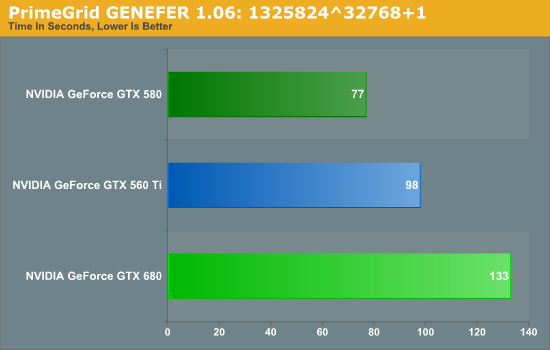
Because it’s based around double precision math the GTX 680 does rather poorly here, but the surprising bit is that it did so to a larger degree than we’d expect. The GTX 680’s FP64 performance is 1/24th its FP32 performance, compared to 1/8th on GTX 580 and 1/12th on GTX 560 Ti. Still, our expectation would be that performance would at least hold constant relative to the GTX 560 Ti, given that the GTX 680 has more than double the compute performance to offset the larger FP64 gap.
Instead we found that the GTX 680 takes 35% longer, when on paper it should be 20% faster than the GTX 560 Ti (largely due to the difference in the core clock). This makes for yet another test where the GTX 680 can’t keep up with the GTX 500 series, be it due to the change in the scheduler, or perhaps the greater pressure on the still-64KB L1 cache. Regardless of the reason, it is becoming increasingly evident that NVIDIA has sacrificed compute performance to reach their efficiency targets for GK104, which is an interesting shift from a company that was so gung-ho about compute performance, and a slightly concerning sign that NVIDIA may have lost faith in the GPU Computing market for consumer applications.
Finally, our last benchmark is once again looking at compute shader performance, this time through the Fluid simulation sample in the DirectX SDK. This program simulates the motion and interactions of a 16k particle fluid using a compute shader, with a choice of several different algorithms. In this case we’re using an (O)n^2 nearest neighbor method that is optimized by using shared memory to cache data.
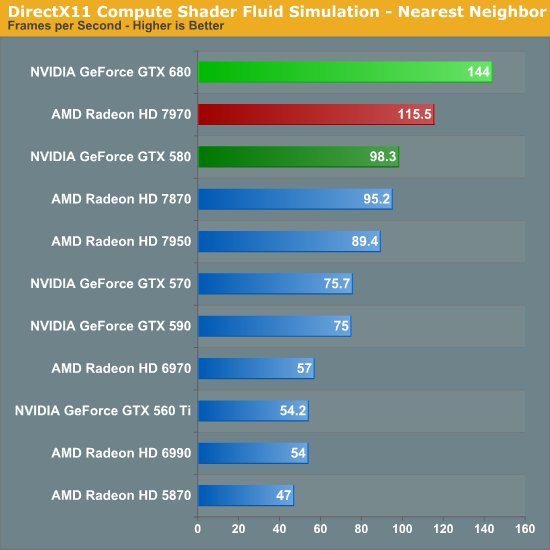
Redemption at last? In our final compute benchmark the GTX 680 finally shows that it can still succeed in some compute scenarios, taking a rather impressive lead over both the 7970 and the GTX 580. At this point it’s not particularly clear why the GTX 680 does so well here and only here, but the fact that this is a compute shader program as opposed to an OpenCL program may have something to do with it. NVIDIA needs solid compute shader performance for the games that use it; OpenCL and even CUDA performance however can take a backseat.










404 Comments
View All Comments
SlyNine - Thursday, March 22, 2012 - link
While I love BF3, it's not the only game that matters, but it is the only example of the 680 beating the 7970 at frame rates that matter. However the 7970 is catching up as the res goes up. If we add 2 monitors does the 680 still win ?BTW Crysis and Metro 2033 FPS matters to me. Do you think the GPU world revolves around you and what you want? You are not the center of the Videocard world.
Eugene86 - Thursday, March 22, 2012 - link
No, the GPU world doesn't revolve around me but as I already said, nobody but you and a handful of other people actually care about the Crysis and Metro benchmarks because almost nobody plays those games anymore.In my example, Battlefield 3 is a current game that is actually played by people so those benchmarks are useful.
The only reason why Crysis and Metro are used are because they are benchmark games that stress the video cards to their limits. This is nice for bragging rights but completely useless in the real world.
Nvidia and AMD both release video cards that are aimed to please their main market, which is gamers who play on a single monitor at 1080p.
SlyNine - Friday, March 23, 2012 - link
So what are you baseing this on? can you give me any sources?I'm not buying a 600$ video card for just one game.
Plus like I said, as the settings go up, they seem to converge. I can't help but wonder if the 7970 would overtake the 680 at some point before we hit 30fps.
CeriseCogburn - Tuesday, March 27, 2012 - link
Then look at SHOGUN 2 total war in this very article man.Wow, s many of you are so controlled and so mindless on things...
" Total War: Shogun 2 is the latest installment of the long-running Total War series of turn based strategy games, and alongside Civilization V is notable for just how many units it can put on a screen at once. As it also turns out, it’s the single most punishing game in our benchmark suite "
680 takes the top in that game man.
Galidou - Sunday, March 25, 2012 - link
''Nvidia and AMD both release video cards that are aimed to please their main market, which is gamers who play on a single monitor at 1080p''Well then it means that gamers can be more than pleased with a radeon 6870 at 140$ that runs everything with 95% graphical options enabled or a gtx 560ti(not the 448 cores version) for around 200$ which performs a little better than the 6870 and still does the trick in everygame at 1080p.
Prices taken from the bay as no regular 560ti was available on newegg for price comparison.
Oh... and for the 5% graphical options you can't turn on, you'll only notice when you go on a sunday walk in your games, but doing so will have you dead in a second if you play online against other players...
b3nzint - Monday, March 26, 2012 - link
i play metro, cysis a lot, amazing graphic! but thats not "real world" to me. maybe if i play bf3 im in real world?CeriseCogburn - Tuesday, March 27, 2012 - link
Shogun 2 total war, the most demanding game in the benches- did you read ?Nvidia GTX680 sweeps the entire resolution set beating the slower 7970 that cannot handle modern demanding games as well,.
akse - Thursday, March 22, 2012 - link
Seems impossible to do such a feat!!! Considering they launched it months later than the competitor!arjuna1 - Thursday, March 22, 2012 - link
Correct??You call +10 fps difference at best, on certain situations, a domination??
The only good thing this will bring is prices down, the rest is truly unremarkable, for both companies.
See you in the 8xxx/7xxx series.
Wreckage - Thursday, March 22, 2012 - link
Maybe I was a bit hasty. I did forget to mention that it hard launched with working drivers and working h.264 encoding, also quiet under load. Impressive++